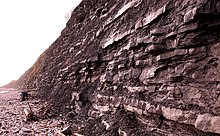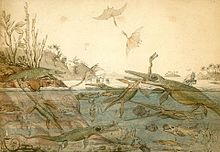Mary Anning
Mary Anning (born May 21, 1799 in Lyme Regis , † March 9, 1847 ) was a British fossil collector . She was one of the first professional collectors of fossils and is therefore considered one of the first paleontologists .
Life
Born in the situated on the southern English coast village of Lyme Regis in Dorset, Mary Anning is said at the age of 15 months as unusual to be noticed: As in 1800 struck a flash in the village, who scored four women, was the only survivor the young Mary. Mary was one of ten children of whom only she and her brother Joseph survived childhood. Mary was named after her eldest sister, already called Mary, who died a few months before she was born at the age of four.
Mary's father, Richard, was a carpenter who supplemented his income by looking for fossils on the cliffs near Lyme Regis, which he then sold to tourists. When he died of tuberculosis in 1810 , the Anning family was left without a breadwinner, and Mary and her brother Joseph began large-scale hunting for fossils that could be sold to supplement the family income.
Collecting fossils had become fashionable in the late 18th and early 19th centuries. Initially no more than a hobby, the importance of fossils for geology and biology was gradually recognized . If Mary Anning started collecting simply to earn a living, she soon had connections with the geologists and biologists of her time.
The first occasion was the discovery of the skeleton of an ichthyosaur , a fish dinosaur , a few months after the death of her father. A year earlier, her brother had discovered a skull that looked like that of a large crocodile. The rest of the skeleton could not be found initially until Mary found the rest of the body after a storm that tore off parts of the cliff. This was the first complete ichthyosaurus skeleton to be found up to that point. Parts of skeletons had previously been found and the species had been described in 1699 using fragments discovered in Wales . However, the important find of a complete skeleton found its way into the Transactions of the Royal Society . Mary Anning was twelve years old at the time.
As it became more popular, it caught the eye of Thomas Birch , a wealthy fossil collector. Touched by the poverty of Mary and her family, he sold his own collection of fossils to the Anning family for £ 400. With a somewhat secure (albeit still very little) financial support, Mary continued her search for fossils, even after her brother found work as an upholsterer .

Their next large fossil find was that of a Plesiosaurus dolichodeirus in 1821, the first that was found of this genus and which has not been surpassed in quality to this day. It was scientifically described by the paleontologist and geologist William Daniel Conybeare . In 1828 she found a pterosaur as the third major find , described by William Buckland in 1829 as Pterodactylus macronyx ( Richard Owen later placed the species in the new genus Dimorphodon ), the first find outside of Germany ( Gideon Mantell believed his pterosaur fossils, described in 1827, to be the Remains of a bird).
With these three significant finds, Mary Anning found her place in paleontology . Her achievement was not only her extraordinary ability to find fossils, but also the care and patience with which she excavated them. She worked on the excavation of the Plesiosaurus for ten years without external support using the simplest of tools. In addition, she - who never had any kind of scientific training - was both able to competently draw and aptly describe her findings.

Mary Anning searched for fossils her entire life and contributed significantly to the development of early paleontology with her discoveries. In her late thirties, she received an annual pension from the British Association for the Advancement of Science in recognition of her achievements.
Mary Anning died of breast cancer at the age of 47 . When her illness became known, the Geological Society of London raised money for her in 1846 . In July 1846, a few months before her death, she was made the first honorary member of the new Dorset Country Museum .
meaning
Mary Anning's findings were important evidence of the extinction of animal species. Up until their time it was the common belief that animal species did not become extinct; every strange find was declared an animal still living somewhere in an undiscovered part of the world. The bizarre nature of the fossils Anning found undermined this argument and supported Georges Cuvier's controversial thesis that they were extinct species. This paved the way for an understanding of life in previous geological ages.
The coast where Mary made her discoveries is now one of the most famous sites for dinosaur fossils in the world. The oldest layers of the coast come from the Triassic and can be dated to an age of approx. 250 million years, the youngest layers come from the end of the Cretaceous - thus they cover a large part of the Mesozoic, an earth epoch dominated by dinosaurs. It is generally Jurassic Coast called and belongs to the world heritage of UNESCO .
Mary Anning herself was forgotten after her death, but has been rediscovered in the last few decades as one of the most important and extraordinary figures in early paleontology.
Others
- It is widely believed that the old English tongue twister " She sells sea shells by the sea shore " came from the English writer Terry Sullivan and is based on the story of Mary Anning.
- More recently she was also the subject of the song “ Do You Know Mary Anning? “The Artichoke Group .
- Tracy Chevalier published the novel Remarkable Creatures in 2009 , which is based on the life story of Mary Anning and Elizabeth Philpot .
- In the novel The Beloved of the French Lieutenant , John Fowles criticizes the fact that not a single British paleontologist named a species after her during her lifetime.
- In 1991 a cluster of flat volcanoes on the northern hemisphere of the planet Venus was named after her: Anning Paterae .
- On May 4, 1999, an asteroid was named after her: (3919) Maryanning .
- The following taxa are named after her:
literature
- Marie Day: Dragon in the Rocks: A Story Based on the Childhood of the Early Paleontologist, Mary Anning. Firefly Books, New York 1995. ISBN 1-895688-38-8 .
- Crispin Tickell: Mary Anning of Lyme Regis. Lyme Regis Philpot Museum, Lyme Regis 1996. ISBN 0-9527662-0-5 .
- Dennis B. Fradin: Mary Anning - The Fossil Hunter (Remarkable Children). Silver Burdett Press, Parsippany NJ 1997. ISBN 0-382-39487-9 .
- Nigel J. Clarke: Mary Anning 1799-1847 - A Brief History. Nigel J Clarke Publications, Lyme Regis Dor 1998. ISBN 0-907683-57-6 .
- Jeannine Atkins: Mary Anning and the Sea Dragon. Illustrations by Michael Dooling. Farrar Straus Giroux, 1999. ISBN 0-374-34840-5 .
- Sally M. Walker: Mary Anning - Fossil Hunter. On My Own Biographies. Carolrhoda Books, Minneapolis 2000. ISBN 1-57505-425-6 .
- Thomas W. Goodhue: Curious Bones - Mary Anning and the Birth of Paleontology. Great Scientists. Morgan Reynolds Pub., Greensboro NC 2002. ISBN 1-883846-93-5 .
- Don Brown: Rare Treasure: Mary Anning and Her Remarkable Discoveries. Houghton Mifflin Co, 2003. ISBN 0-618-31081-9 .
- Thomas W. Goodhue: Fossil Hunter - The Life and Times of Mary Anning (1799-1847). Academica Press, Bethesda 2004. ISBN 1-930901-55-0 .
- Sheila Cole: The Dragon in the Cliff. A Novel Based on the Life of Mary Anning. iUniverse, Lincoln Neb 1991, 2005. ISBN 0-595-35074-7 .
- Laurence Anholt: Stone Girl Bone Girl: The Story of Mary Anning. Frances Lincoln Publishers, New York 2006. ISBN 1-84507-700-8 .
- Patricia Pierce: Jurassic Mary - Mary Anning and the Primeval Monsters. Sutton Publishing, Stroud 2006. ISBN 0-7509-4039-5 .
- Bernhard Kegel : Extinct, to stay. Dinosaurs and their descendants. DuMont, Cologne 208, ISBN 978-3-8321-6495-9 .
Web links
- Extra History: Mary Anning - Princess of Paleontology
Individual evidence
- ↑ Yvette Gayrard-Valy: Witnesses of prehistoric times. Ravensburger, 1990. p. 102
- ^ Peter Wellnhofer : The great encyclopedia of the pterosaurs , Mosaik Verlag, Munich, 1993. pp. 27-29
- ^ Bill Bryson : A short History of nearly Everything. Broadway Books, New York 2003, pp. 114f. ISBN 0-552-15174-2
- ↑ a b Shelley Emling: The fossil hunter: dinosaurs, evolution, and the woman Whose discoveries changed the world . 1st ed. Palgrave Macmillan, New York 2009, ISBN 978-0-230-61156-6 .
- ^ A b Hugh Torrens: Mary Anning (1799-1847) of Lyme; 'the greatest fossilist the world ever knew' . In: The British Journal for the History of Science . tape 28 , no. 3 , 1995, ISSN 1474-001X , p. 257–284 , doi : 10.1017 / s0007087400033161 ( cambridge.org [accessed July 8, 2017]).
- ↑ Emling, Shelley .: The fossil hunter: dinosaurs, evolution, and the woman Whose discoveries changed the world . 1st ed. Palgrave Macmillan, New York 2009, ISBN 978-0-230-61156-6 , pp. 48-49 .
- ↑ Marco Evers: The grave of God. in: Der Spiegel. Hamburg 2008, 2, p. 128ff. ISSN 0038-7452
- ^ Bill Bryson: A short History of nearly Everything , 115
- ↑ The Wyrdest Greek , accessed December 27, 2011
- ↑ Two remarkable women. ( Remarkable Creatures. ) Knaus Verlag, Munich 2010, ISBN 978-3-8135-0368-5
- ↑ Anning Paterae in the Gazetteer of Planetary Nomenclature of the IAU (WGPSN) / USGS (English)
- ↑ The Minor Planet Circulars of May 4, 1999, page 34619 (English)
- ↑ Emling, Shelley .: The fossil hunter: dinosaurs, evolution, and the woman Whose discoveries changed the world . 1st ed. Palgrave Macmillan, New York 2009, ISBN 978-0-230-61156-6 .
- ↑ Peggy Vincent, Roger BJ Benson: Anningasaura, a basal plesiosaurian (Reptilia, Plesiosauria) from the Lower Jurassic of Lyme Regis, United Kingdom . In: Journal of Vertebrate Paleontology . tape 32 , no. 5 , September 1, 2012, ISSN 0272-4634 , p. 1049-1063 , doi : 10.1080 / 02724634.2012.686467 .
- ^ Dean R. Lomax, Judy A. Massare: A new species of Ichthyosaurus from the Lower Jurassic of West Dorset, England, UK In: Journal of Vertebrate Paleontology . tape 35 , no. 2 , March 4, 2015, ISSN 0272-4634 , p. e903260 , doi : 10.1080 / 02724634.2014.903260 .
| personal data | |
|---|---|
| SURNAME | Anning, Mary |
| BRIEF DESCRIPTION | British fossil collector and early paleontologist |
| DATE OF BIRTH | May 21, 1799 |
| PLACE OF BIRTH | Lyme Regis |
| DATE OF DEATH | March 9, 1847 |
